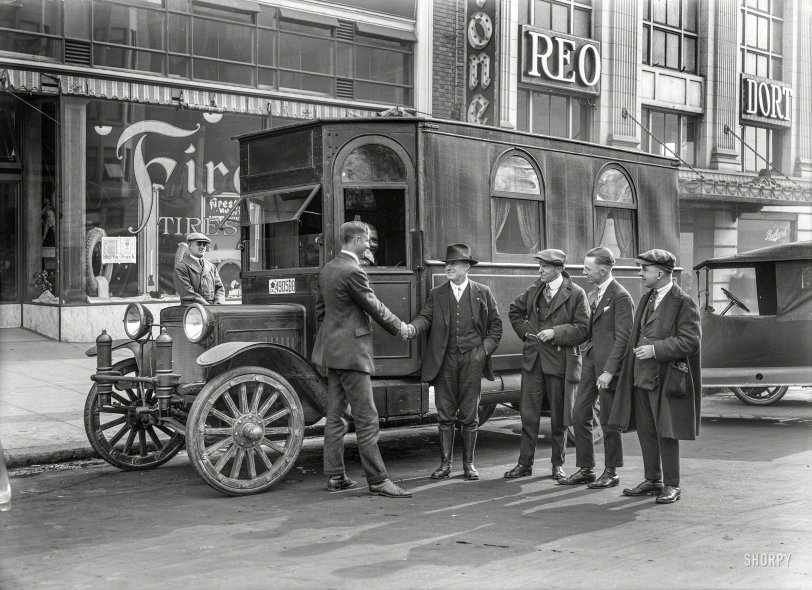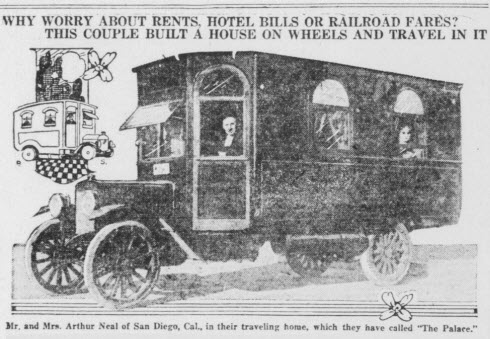


Framed or unframed, desk size to sofa size, printed by us in Arizona and Alabama since 2007. Explore now.
Shorpy is funded by you. Patreon contributors get an ad-free experience.
Learn more.

- Freeze Frame
- Texas Flyer wanted
- Just a Year Too Soon
- WWII -- Replacing men with women at the railroad crossing.
- Yes, Icing
- You kids drive me nuts!
- NOT An Easy Job
- I wonder
- Just add window boxes
- Icing Platform?
- Indiana Harbor Belt abides
- Freezing haze
- Corrections (for those who care)
- C&NW at Nelson
- Fallen Flags
- A dangerous job made worse
- Water Stop
- Passenger trains have right of way over freights?
- Coal
- Never ceases to amaze me.
- Still chuggin' (in model form)
- Great shot
- Westerly Breeze
- For the men, a trapeze
- Tickled
- Sense of loneliness ...
- 2 cents
- Charm City
- What an Outrage
- Brighton Park
Print Emporium
Welcome, Wagon: 1919

San Francisco circa 1919. "Bus" is all it says on the sleeve of this 5x7 glass negative showing a motor home on an Atterbury truck chassis. In the Firestone display window, it's beginning to look a little like New Year's. View full size.
The Palace
Almost certainly, the gentleman standing just to the right of the driver's door is Arthur M. Neal (1869 - 1938) who built this traveling home for himself and his wife Fannie I. Neal (1871 - 1965). Having been the proprietor of the Hotel Arthur (1911-1912) and the Hotel Yale (1913 - 1919) in San Diego, he knew what accommodations were needed when traveling away from home. They nicknamed their vehicle "The Palace." The San Diego commercial automobile body firm of Klersy & Caldwell provided assistance with the build of the motorhome which was painted brown. Based on California vehicle registrations, the Atterbury was used by the New Southern Hotel as a bus prior to the Neal's ownership. It is likely a Model D built circa 1914.
Newspaper articles start appearing with photos of their mobile home in October, 1919, but the couple stated in the Roseburg [Oregon] Review, on October 3rd, that they had been on the road for eight months already. All of the earliest newspaper photos of their caravan do not show the Gruss shock absorbers installed, leading me to wonder if perhaps the Firestone dealer installed the devices for the Neal's. After visiting San Francisco their intent was to head east for a year.
The article below, from the magazine "Sunset," published in June 1920, describes more about their vehicle and the Neal's extended travels. This article is the last published piece I found about their excursion. The pair returned to San Diego later in 1920 or early 1921 where they became the managers of an apartment building at 1313 24th Street until Arthur Neal passed away in 1938. Fannie Neal continued residing there until just after WWII, but, even after leaving this apartment, she remained in San Diego for the rest of her life. She died at the age of 93 in 1965.


Mystery hardware
I can usually identify most components of early automobiles, but those vertical cylinders which appear to be attached to the forward end of the front springs have me baffled.
Some sort of primordial air suspension or shock absorber??
Shock absorbers, probably by Gruss, as seen and commented on in this photo. -tterrace]
Automobile Row again
Earle C. Anthony's REO and Dort dealership was at 1400 Van Ness Ave., with Firestone Tire & Rubber (F.C. Flickinger, manager) next door at 1414.
San Francisco Planning Commission on 1400 Van Ness: "This is a fine restrained Classical Revival auto showroom with a rusticated base and Corinthian pilasters. The bay and pilaster width relate to the width of the street, with the Van Ness facade having a larger scale than the Bush facade. Because of the building’s corner location it would be difficult to alter or add to without significantly harming its integrity; therefore the building should remain intact."
Cross-Country
Atterbury trucks were made in Buffalo, New York.
























On Shorpy:
Today’s Top 5